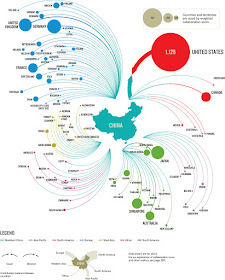by Salman Hameed
In terms of scientific research output, China is now just behind the US (in terms of "high-quality science" as defined by the journal Nature and that takes into account articles from 68 natural science journals). Just this past week, Nature Index published a fascinating map of Chinese science collaborations, and it is clear from it that it is becoming a global science superpower:
I am surprised at the relatively small levels of collaborations with both India and Pakistan. And stranger still, Saudi Arabia is the 12th largest collaborator (though, much of that collaboration is driven by Chinese researchers - but still, interesting). Here is the map of Chinese international collaborators:
Perhaps, most importantly, Nature Index reveals that Chinese collaborators are not just getting their names on the papers, but are major contributors to the papers (and skewed towards China in the case of UK):
It is just fascinating to see the stunning rise of China in the last decade or so in almost all spheres of life. You can read the full report here (you may need subscription to access it).
In terms of scientific research output, China is now just behind the US (in terms of "high-quality science" as defined by the journal Nature and that takes into account articles from 68 natural science journals). Just this past week, Nature Index published a fascinating map of Chinese science collaborations, and it is clear from it that it is becoming a global science superpower:
After more than a decade of strong investment in research and higher education, China is becoming an important partner for the scientific powerhouses of North America and Europe, and a growing hub for international collaboration. Mapping the many Chinese international collaborations in the Nature Index (see 'China's global network') demonstrates the extent to which Chinese scientists have become innovative contributors to, and leaders of, many international scientific communities.
Like many nations, China's biggest collaborator in the Nature Index is the United States, the biggest index contributor overall, with a collaboration score more than five times that of its next strongest collaborating country, Germany (See 'China's closest links'). For China a contributing factor is the large number of Chinese researchers who have spent time in the global science superpower. A large diaspora of Chinese-heritage scientists around the world, particularly in the United States, have forged bonds between researchers in China and elsewhere.Here is the map of articles from 2014 (you can click on the figure to enlarge it):
I am surprised at the relatively small levels of collaborations with both India and Pakistan. And stranger still, Saudi Arabia is the 12th largest collaborator (though, much of that collaboration is driven by Chinese researchers - but still, interesting). Here is the map of Chinese international collaborators:
Perhaps, most importantly, Nature Index reveals that Chinese collaborators are not just getting their names on the papers, but are major contributors to the papers (and skewed towards China in the case of UK):




No comments:
Post a Comment